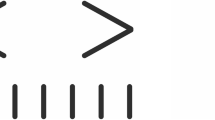Abstract.
A combined influence of stimulus orientation and structure on the judgement of length was tested in psychophysiological experiments. The subjects adjusted the test part of a stimulus to be equal in length to the reference part. The orientation of the parts of the stimulus varied in the experiments. The stimuli (three dots or the Oppel-Kundt figure, which had ten dots within the filled part) were generated on the monitor. In the Oppel-Kundt figure, the filled part was considered as a reference and the empty part as a test. In sessions of the experiments, values of errors were measured as functions of the size and orientation of the stimulus. The reference part length varied within 14–150 min arc range, and the orientation was fixed in 0°, 90°, 180° or 270° positions. The orientation of the test part varied from 0° to 360° in 7° steps. We assume, that the experiments with the three-dot stimuli yielded pure characteristics of visual field anisotropy, while those with the Oppel-Kundt figure showed the combined effect of both the components (anisotropy and spatial filtering). The data demonstrated independence of the two factors from each other in a simultaneous manifestation. The characteristics of a pure Oppel-Kundt illusion have been found to be in close correspondence with the predictions of the model of spatial filtering.
Similar content being viewed by others
Author information
Authors and Affiliations
Additional information
Received: 1 July 1998 / Accepted in revised form: 4 November 1998
About this article
Cite this article
Bulatov, A., Bertulis, A. Distortions of length perception. Biol Cybern 80, 185–193 (1999). https://doi.org/10.1007/s004220050516
Issue Date:
DOI: https://doi.org/10.1007/s004220050516




